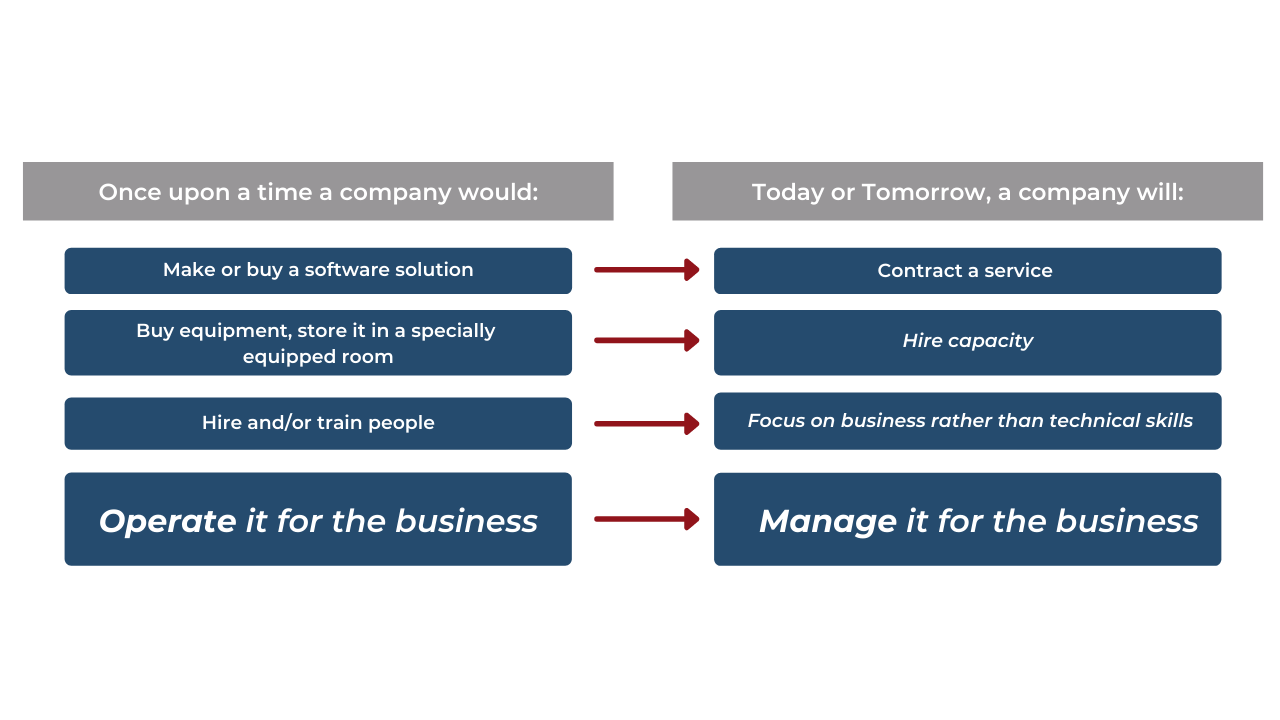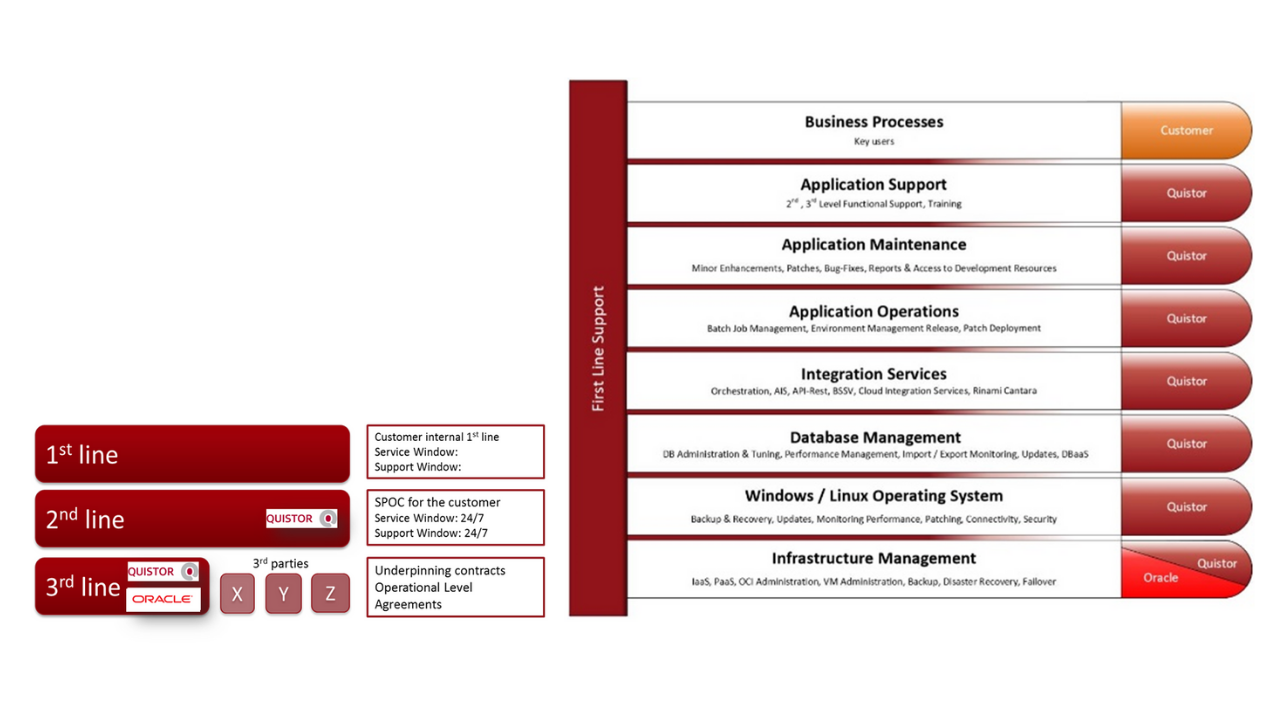Completing your approach: Managed Services Technical for Cloud solutions
Completing your approach: Managed Services Technical for Cloud solutions
Objective
In this article, I will discuss the processes, tools, and benefits of Technical Managed Services: Why you need it? Is it relevant if you go to the Cloud? How does it work? Who can deliver it? What are the benefits?
I will use different angles and viewpoints: what the business expects from this type of service, how it affects the people & organisation delivering the service, and what issues and opportunities there are in putting the processes and tools in motion.
Context
Within the early years of my 30year+ career (omg), a company would: make or buy a software solution, buy equipment, store it in a specially equipped room, hire and/or train people, operate the solution for the business.

Are you at the start, in the middle or at the end of this evolution? If there is one constant that I witnessed first-hand throughout my career, it is that with every new step and possibility, new and different people get a seat at the table. Naturally, the group required to run and manage solutions smoothly and meet the expectations successfully gets bigger and bigger.
This evolution can be represented in a graph, demonstrating the increasing complexity of requirements and expectations, progressing at more or less the same pace as advances within technology.

Operating or managing the solution is a service component. The more complex the solution or collection of solutions you want to service, the more expertise required.
What are the specific needs or requirements?
Your company is using JD Edwards for its contribution to the business, whether that be within finance, logistics, sales, manufacturing or all of them. It is likely that business has changed since JD Edwards was first deployed. New activities may have been incorporated, new countries included in the scope, more functionalities have been deployed. But that is not all that has changed. The way we do business in general and the requirements we put on IT tools to support this, has changed dramatically. Every day, more demands are made in terms of availability, performance, connectivity. Some examples we see with our customers are:
- the need to produce high quality customer facing documents
- the need to integrate with front end applications on the web and/or mobile devices
- more operating hours, less time available for housekeeping, deployments, and backups
- demands for new functionality and capabilities, which require new versions of one or more of your applications, or all of them
- demands for SLA from the business, related to specific processes
- more partners are working on a process, increasing the need for integration and collaboration tools
- access and role security following new legislation
What are the challenges?
All this has consequences for your application: pushing JD Edwards boundaries outwards and adding and integrating new solutions to the applications portfolio. If you consider this together with the increased velocity of doing business, IT service departments face constraints that push them in different directions:
- New versions need to be deployed
- New solutions need to be integrated
- Service windows need to be extended up to 24/7
- Downtime needs to be reduced
- Performance needs to be maintained or improved
End users want to be heard and hold IT accountable for service levels. Inspired by the way Cloud offerings are managed, the business demands the best possible service for its budget, with proof and documentation, require a level of governance that is more detailed and more formalised than before:
- Incident tracking and follow up
- Number of incidents by type and severity
- Application Uptime and Downtime
- Details on unplanned outages with proposed actions to remediate and avoid
- KPI’s on performance
- Recommendations for future investments, with hard justification
- Monitor true end-user experience
To achieve this, you need processes that enable this, supported by tools that facilitate this:
- Capture events and their resolution to learn from incidents. Finding root causes takes time and should be documented as lessons learned
- Integrate monitoring and alerts across different products, technologies and layers of the stack
- Log screening is time consuming and complex. Log parsing analyses text-based files to identify issues before they affect users
- Translate monitoring alerts into actionable instructions
- Benchmark your operations and service levels
- Report on metrics & KPI’s
There are also consequences on your staff:
- You need to balance their availability or organisation between support tasks vs projects: do you prefer to meet project deadlines or to keep up service levels?
- They need to acquire and maintain product expertise on an expanding product portfolio , and at the same time be on top of new technological evolutions
- They need to find fulfilment and challenge in providing quality service as much as in driving projects.
How to meet these challenges?
Faced with the questions above, a company has to put practices in place, aswell as tools to meet these requirements. This can include:
- Gather metrics on System availability and performance and make them available for reporting and analysis.
- Develop insight into critical business processes, and define suitable metrics
- Establish ongoing communication between the business, business analysts, application manage, delivery teams, and support teams
- Budget Control Analytics
Quistor uses event and ticket management tools to collect and centralize all data and internal and external communications related to an alert, incident, or request. This way, we create a factual basis for driving change. We use ticket classification to organise the process. We keep track of total effort and throughout time for each activity. This data is available in real-time, for analysis, making decisions, and communication. If required and appropriate, status alerts and automated communications keep the customer team informed of what is going on.
Quistor uses specialised tools to monitor not only system metrics and availability, but more importantly the application availability. We can go as far as monitoring a process through every step across different applications, no matter whether it is within the company or externally. Data from incidents also gets compiled into general and customer-specific Known-Error procedures for a quicker resolution to future system issues. This means faster resolutions to problems, as well as a basis to propose measures to prevent recurring problems.

Quistor service desk is available 24/7, and we routinely perform tasks outside office hours, e.g. at the weekend, to minimise disruption when the business needs the application to work.
These procedures and tools only yield the expected result if the organisation and people working with them are up to it. Quistor consultants have all the specialisations and certifications needed to support the full stack, from OS up to the application and the business. Our collaborative work environment enables greater productivity by working alongside each other. We develop a shared-team knowledge base for future reference.

We offer true 24/7 eyes on screen availability, enabling us to support customers globally and execute tasks outside business hours, relieving the pressure on your internal teams.
Benefits
Whether you are already operating on the Cloud, or on your journey towards it:
- You will have access to expertise when you need it, how you need it.
- Cost-effective, scalable monitoring that allows you to identify and eliminate performance issues and bottlenecks before they impact your ERP environment and applications architecture.
- You will have the flexibility your business requires to adapt quickly to evolutions in your application portfolio, new tools, and solutions to deploy.
- We help you increase the speed of implementing decisions that drive bottom-line results.
- The Quistor Managed Services framework is a Cost-Effective service, delivering High
- Our framework enables formal accountability to the business, with SLA metrics and KPI’s to document it in a formalised governance model.
- We deliver the actionable information that Oracle JD Edwards users need to proactively resolve issues before they grow into problems.



